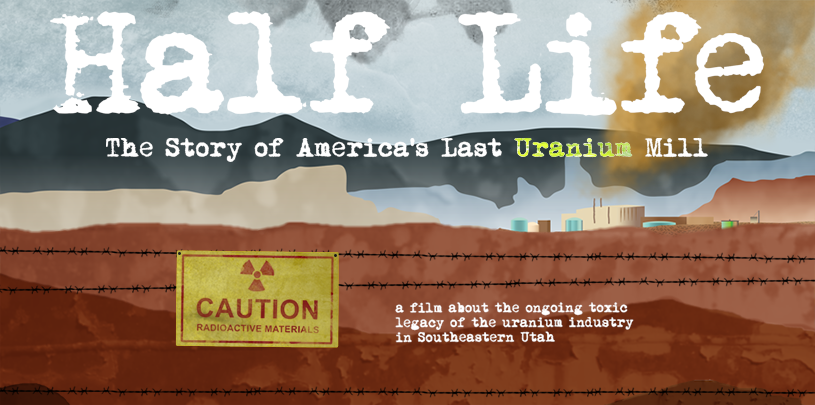
 by Anne Mariah Tapp, Energy Director
by Anne Mariah Tapp, Energy Director
The company seems far more concerned with media leaks than with leaks into the surrounding groundwater.
—Dave Sweeny, Australian Uranium Activist
From the highway, it’s easy to miss the White Mesa uranium mill. Thousands of tourists, mountain bikers, climbers, and river rafters shuttle past it each year on southeastern Utah’s U.S. Route 191, a popular corridor connecting Arches and Canyonlands national parks to Monument Valley on the Navajo Nation.
Hurtling between stunning vistas at 55 miles-per-hour, you might not notice the discreet sign or narrow track leading toward a series of drab, low-slung industrial buildings, and few would guess that this turnoff leads to one of the least understood toxic sites in the Southwest: the nation’s last operating conventional uranium mill.
Horses graze in pastures along the highway, a lone gas station operates nearby, but outside of several hundred members of the Ute Mountain Ute Tribe’s White Mesa community, located about three miles away, and a few dozen uranium mill employees who mostly commute from outlying towns, almost no one stops in White Mesa. And with the mill hidden behind berms and security fences, the extent of the complex and its real purpose have been largely unknown, even to people living in White Mesa, until now.
The Grand Canyon Trust has teamed up with filmmaker Justin Clifton to create a new documentary, “Half Life: The Story of America’s Last Uranium Mill,” to raise public awareness about the risks of toxic and radioactive contamination from the White Mesa Mill.
People at the state and government level really need to look at this.
—Malcolm Lehi, Ute Mountain Ute Tribal Councilman
As the film shows, if you were to venture a little farther down the White Mesa Mill turnoff, you would find a keystone of America’s uranium and nuclear industry. The White Mesa Mill is the destination for thousands of tons of uranium ore mined on public lands surrounding the Grand Canyon. It is also the final resting place for toxic and radioactive waste shipped to White Mesa from Superfund and military testing sites across the United States.
While the view from the road is discreet, an eagle’s-eye view tells a very different and disturbing story. The mill’s ethereal blue toxic waste ponds cover an area more than twice the size of the Mall of America. One of the mill’s smallest ponds—called “tailing cells”—stores up to 133 million gallons of toxic and radioactive waste, the equivalent of more than 200 Olympic swimming pools. These ponds, some of which have long-outdated liners and leak-detection systems, are located directly above the Navajo Aquifer, which provides drinking water to the Ute Mountain Ute Tribe’s White Mesa community and towns across southeastern Utah and northern Arizona.
If contamination did show up in these seeps and springs these resources would be unusable for the tribe.”
—Colin Larrick, Water Quality Specialist, Ute Mountain Ute Tribe
As the last operating conventional uranium mill in the United States, the White Mesa Mill serves as the keystone for much of North America’s uranium industry. And because the story of uranium on the Colorado Plateau is also a story of environmental injustice—with the industry’s impacts borne disproportionately by tribal nations—the White Mesa Mill is also a keystone for environmental justice across the Southwest and North America.
The American public has a right to know the story of the White Mesa Mill and the threat the mill poses to the people who call this corner of the Southwest home—particularly the people of the Ute Mountain Ute Tribe whose ancestral ties to the lands currently used by the mill date back thousands of years.
We believe that the people, ecosystems, and lands of the Colorado Plateau and greater Grand Canyon region deserve a future free of radioactive contamination.
With the mill slated to continue operating for decades to come, we have an opportunity to tell decision-makers that we are concerned about the mill. We have an opportunity to raise our voices about the White Mesa Mill and push for cleanup of toxic sites. We hope the film inspires you to learn more, get involved, and take action.
*This blog entry was updated on 10/5/2016.
A small victory in the legal case challenging Daneros uranium mine, near Bears Ears National Monument.
Read MoreGroundwater pumping at a uranium mine near the Grand Canyon will affect the canyon's springs, scientists says.
Read MoreA rally in Salt Lake City followed by a spiritual walk in White Mesa demonstrate the Ute community's determination to see uranium mill close.
Read More